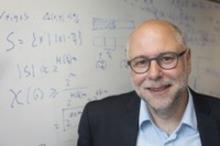Harry Buhrman joins Royal Netherlands Academy of Arts and Sciences.

Quantum researcher Harry Buhrman joins the Royal Netherlands Academy of Arts and Sciences (KNAW). The KNAW is the most relevant Dutch society of top scientists. Together with seventeen other researchers, Buhrman will be installed as a new Academy member on September 14, 2020. Buhrman is affiliated with the CWI and the University of Amsterdam. He is also director and founder of research institute QuSoft, which focuses on the development of quantum software and applications of quantum computers and quantum networks.
Buhrman receives the KNAW membership for his exceptional scientific achievements. His research focusses on the interface of computer science, mathematics and physics. The common thread in his career is the understanding of the computing power and possibilities of computers and communication networks. Buhrman achieves this by designing new algorithms and communication protocols, and by developing techniques that demonstrate their optimality. He gained international fame for his work on quantum communication and quantum lower bounds.
Programming future computers
Back in the early 1990's, mathematician Peter Shor was the first to come up with a useful and practical algorithm for a quantum computer, allowing to crack codes faster. From that moment on, this area of quantum research gained tremendous momentum.
Buhrman became fascinated by the possibilities of quantum computers and quantum communication. He discovered that quantum bits, the building blocks of quantum computers, can also be instrumental when used as information carriers. Despite that it was already known that it is impossible to compress a random message into fewer quantumbits than conventional classical bits he showed that some distributing problems can be solved with less quantum communication than classical communication.
An example of this is the so-called agenda problem, where two parties want to make an appointment and are able to do so with much less quantum than classical communication. An efficient quantum solution of the well-known Doodle.
“It may sound crazy to describe protocols for computers and communication networks that do not yet exist,” says Buhrman. “But in fact, it’s nothing new and very relevant." He refers to Dutch computer pioneer Edsger Dijkstra. Already in the 1950’s, while at the institute currently known as CWI, Dijkstra designed applications for a computer that still was being developed.
Dijkstra devised algorithms and applications that could not yet be run on a computer, since they were at that time not available. An example is Dijkstra’s algorithm that calculates the shortest route from A to B. Nowadays, all navigation systems work with a variant of his algorithm. “It is also very important nowadays to already write programs and come up with applications for quantum computers that are not yet here.”
Quantum view
At an early age, Buhrman knew that he wanted to become a scientist. As a ten-year-old, he saw a television broadcast about programming, his interest in computers was awakened. Buhrman: "The fact that you can cleverly give a device a large number of commands and that these are then literally executed fascinated me”.
Although other disciplines such as biology, chemistry and physics also intrigued him, Buhrman was one of the first in the Netherlands to study computer science. In the meantime, he has come into contact with these fields again, because quantum computing can also be applied there. "I think it's wonderful that through my knowledge of quantum computing I can also be of value for these other disciplines. Simulating biological or chemical processes, for example, is something quantum computers can do better than classical computers. Another beautiful side effect is that by looking at classical problems through 'quantum glasses' we can sometimes take a smart turn and find solutions that would otherwise not be possible".
New infrastructure
In 2015 Buhrman founded the quantum research institute QuSoft, with which he wants to develop applications for quantum computers that will be available in the near future. “You can't do anything with a computer without software. QuSoft is the first institute in the Netherlands in this field and belongs to the world top. But only QuSoft is not enough, we must continue to emphasize the importance of quantum software,” says Buhrman.
Although quantum computers will only be able to run software in about ten years’ time, Buhrman believes that we need to make this this a major effort now. Buhrman: “It requires a completely new infrastructure, way of thinking, and programming to be able to develop quantum applications. For this we need a lot of manpower and therefore need to train a new generation of researchers.”
